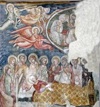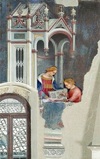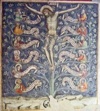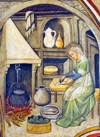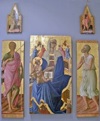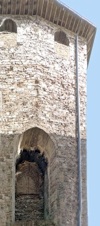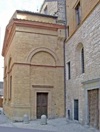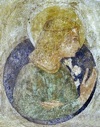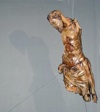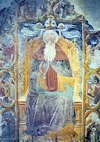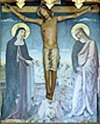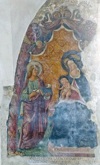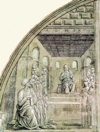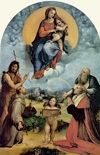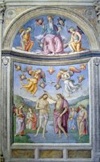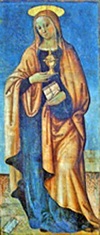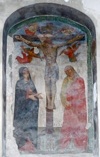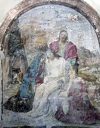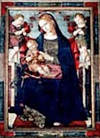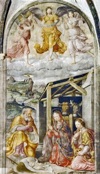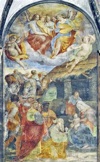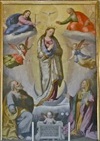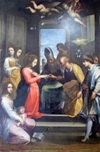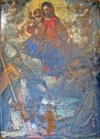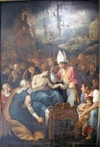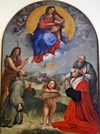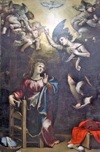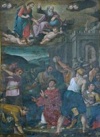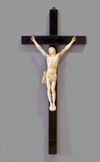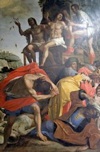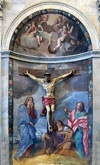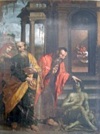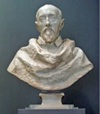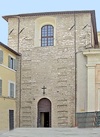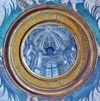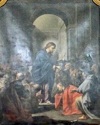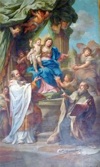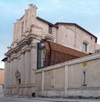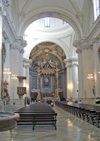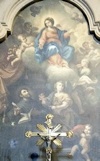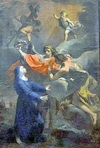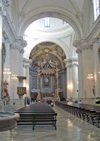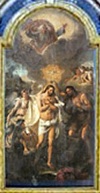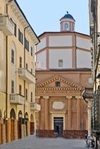

Cola Petruccioli (died 1401)
Cola Petruccioli began his career in his native Orvieto. He moved to Perugia in ca. 1380 and this was where he died. A number of fresco fragments in San Domenico are attributed to him, including the upper part of a scene of the Assumption of the Virgin illustrated here.
Maestro della Dormitio di Terni (ca. 1400)
Probably from Terni
Three dispersed panels from a triptych that is attributed to this master might have come from San Bartolomeo di Marano.
[Temporary link to the Maestro della Dormitio di Terni]
Maestro dell' Abside Destra di S Francesco (early 15th century)
This fresco (1391) of the Dormition and Coronation of the Virgin in Santa Maria Giacobbe , which is dated by inscription, is attributed to the Maestro dell’ Abside Destra di San Francesco di Montefalco. If this attribution is correct, it is the only dated work by this artist that survives. It is therefore of great value in dating his other works and might, in time, provide a clue to his identity. There are a number of other frescoes attributed to this master in San Domenico.
Gentile da Fabriano (died 1427)
From Fabriano
Paolo Nocchi (died after 1436)
From Foligno
Paolo Nocchi is named among the collaborators of Gentile da Fabriano in relation to the frescoes (1411-2) in Palazzo Trinci.
[Temporary link to Paolo Nocchi]
Giovanni di Corraduccio Mazzaforte (died after 1437)
Text
Andrea di Cagno (died after 1446)
Text
Ottaviano Nelli (1375 - ca. 1450)
An inscription on the alter wall of the chapel of Palazzo Trinci record that Ottaviano Nelli painted its frescoes in 1424. They include the fresco of the Crucifixion with saints illustrated here, and an extensive cycle of scenes from the life of the Virgin.
Bartolomeo di Tommaso (ca. 1408-54)
Text
Bartolomeo di Mattiolo (died 1473)
Bartolomeo di Mattiolo, who was based in Perugia from at least 1437, became the leading architect in that city. A number of payments were made to him in 1457-9 in connection with the rebuilding of the apse of the Duomo. Most of the work was lost during subsequent restorations, but vestiges of the traceried windows from this construction are still visible from the exterior of the church.
Neri di Monte (died after 1488)
Stained glass panels (1485-8) from the tribune of the Duomo of Foligno, which are the documented work of Neri di Monte, were sold to the friars of San Francesco, Assisi in 1785 and are now in the Museo del Tesoro di San Francesco. A detail from the panel depicting St Felician is illustrated here.
Francesco da Pietrasanta (died 1494)
Pope Sixtus IV probably sent Francesco da Pietrasanta from Rome to Foligno, where he is first documented as the director of work on the Palazzo Apostolico (ex Palazzo Trinci) in 1477. He subsequently directed most of the important architectural projects in the city. The design of the Oratorio della Nunziatella (1494, illustrated here) is attributed to him.
Benozzo Gozzoli (1420-97)
This damaged detached fresco (ca. 1449) of the head of an angel in a tondo came from the chapel to the right of the presbytery in San Domenico and is now in the Pinacoteca Civica. It was probably on the side of an entrance arch, opposite another of the Virgin Annunciate. It is attributed to Pierantonio Mezzastris or Benozzo Gozzoli: it is almost certainly based on the cartoon that was used for Benozzo’s fresco of the Annunciation in Narni. It has to be said, however, that there is no documentary evidence that Benozzo was ever in Foligno.
Giovanni Tedesco (late 15th century)
Two Crucifixes in Foligno are attributed to Giovanni Tedesco:
-
✴a fragment from Palazzo Vescovile that is now in the Museo Capitolare e Diocesano (illustrated here); and
-
✴a Crucifix hangs over the high altar of Santa Lucia, which Gismondo di Foligno, the father of one of the nuns, gave a Crucifix to the community in 1522.
Nicolò di Liberatore, l' Alunno (1430-1502)
Nicolò di Liberatore was perhaps the most important participant in the vibrant artistic milieu of Foligno in the 15th century. [More]
Cristoforo di Jacopo (died after 1502)
Text
Pietro di Giovanni Mazzaforte (died after 1502)
Text
Ugolino di Gisberto (died after 1502)
Ugolino, who became a citizen of Foligno, signed a contract for a year-long apprenticeship in the workshop of Pietro di Giovanni Mazzaforte and Nicolò di Liberatore, l’Alunno (above) in 1458. His only known signed work, a damaged fresco (early 16th century) in Santa Maria Infraportas, Foligno, is illustrated here.
Valerio de’ Muti (died after 1502)
From Foligno
Valerio di Giacomo de’ Muti is documented in Foligno on a number of occasions in the period 1471-1502, but no securely attributed work by him survives in his native city. Signed works do survive, however, in Spello and Trevi.
[Temporary link to Valerio de’ Muti]
Pierantonio Mezzastris (ca. 1430-1506)
Pierantonio Mezzastris was one of the most prolific artists at Foligno in the second half of the 15th century,
Andrea d' Assisi, l’ Ingegno (died 1520)
From Assisi
Cola di Matteuccio da Caprarola (died after 1519)
From Caprarola, near Viterbo
Cola worked on the remodelling of the Duomo in 1512-5. A vault collapsed in 1513, and he was required to repair the damage at his own expense.
[Temporary link to Cola da Caprarola]
Francesco Melanzio (ca. 1465-1520)
From Montefalco
Raphael (1483-1520)
Sigismondo de' Conti da Foligno commissioned the altarpiece (ca. 1511) known as the Madonna di Foligno from Raphael for his funerary chapel in Rome. His niece, Anna de' Conti arranged for it to be moved to Sant' Anna, Foligno in 1565, and it remained there until the French confiscated it in 1797. It is now in the Pinacoteca Vaticana
Pietro Vannucci, il Perugino (1446–1524)
This fresco (1507) of the Baptism of Christ, with God the Father above, is behind the Altare di San Giovanni Battista, in the Oratorio della Nunziatella. The original inscription gave the date and the name of Perugino.
Lattanzio di Nicolò (died after 1527)
Lattanzio di Nicolò trained under his famous father, Nicolò di Liberatore, l’Alunno (above). This votive panel (1507) of St Mary Jaocobi from the oratory of Santa Maria Giacobbe, Pale is signed and dated by inscription. It was stolen in 1964 but recovered soon afterwards and is now in the Museo Diocesano.
Bernardino Mezzastris (died after 1539)
Bernardino was the son of the more famous Pierantonio Mezzastris (above). He emerged as an independent painter after his father’s death in 1506. No signed works by Bernardino Mezzastris survive in Foligno, but a number of works in the city are attributed to him. These include this fresco (1525) of the Crucifixion in Santa Maria Infraportas.
Giannicola di Paolo (ca. 1460-1544)
From Perugia
Antonio da Sangallo il Giovane (1484-1546)
From Florence
Antonio da Sangallo il Giovane was one of the leading architects in Rome, particularly after the election of Pope Paul III in 1534. He worked on the remodelling of the Duomo in 1517-22. His surviving sketches depict the crossing, crypt and cupola and also the Cappella del Corpus Domini, off the left transept. He was documented again in Foligno in 1525, when he requested and was granted citizenship.
[Temporary link to Antonio da Sangallo il Giovane]
Bernardino di Mariotto (died 1566)
Bernardino di Mariotto spent the first part of his career in San Severino in the Marches, before returning to Perugia in 1521. A panel (early 16th century) of the Madonna and Child enthroned from St Lucia, which is now in the Pinacoteca Civica, is attributed to him.
Dono Doni (1505-75)
Three works in Foligno are attributed to Dono Doni:
-
✴a fresco (1544) of the Nativity with St Lucy on the altar wall of the nuns’ choir the Monastero di Sant’ Anna (illustrated here);
-
✴the frescoed frieze (ca. 1545) of Sala Papale, Palazzo Trinci; and
-
✴a fresco (16th century) of the Martyrdom of St Catherine of Alexandria from Santa Caterina Vecchia, which is now in the Pinacoteca Civica.
Lattanzio Pagani (died ca. 1582)
From Monterubbiano, in the March of Ancona
Lattanzio Pagani worked mainly for Pope Paul III and for Cardinal Tiberio Crispo, who was the the papal legate in Umbria in 1545-8. He neglected his work as an artist from 1553, when he became Captain of the Militia of the provinces of Umbria and the Marche. A fresco (ca. 1546) of the arms of Tiberio Crispo in Palazzo Trinci is attributed to him.
[Temporary link to Lattanzio Pagani]
Nicolò Circignani, il Pomarancio (died 1596)
This fresco (1567) of the Adoration of the Magi, which is attributed to Nicolò Circignani, is on the right wall of the nuns’ choir in the Monastero di Sant’ Anna. It is dated by an inscription that also records the name of the donor, Bishop Ventura Bufalini.
Felice Damiani (died after 1609)
Felice Damiani left a executed a number of works in his native city in the period from ca. 1594 until his death. Two signed altarpieces in Foligno are from a slightly earlier date:
-
✴the Immaculate Conception (1592) in San Bartolomeo di Marano (illustrated here); and
-
✴the Madonna della Cintura (1593) in Sant’ Agostino.
Ventura Salimbeni (1571-1613)
Ventura Salimbeni became one of the most appreciated artists of his time. Two of his signed works survive in Foligno:
-
✴an altarpiece (1610) of the Adoration of the shepherds (1610) in Sant’ Agostino; and
-
✴an altarpiece (1613) of the Marriage of the Virgin in the Museo Capitolare Diocesano, which he probably painted for the Duomo and which is his last known work (illustrated here).
Cristoforo Roncalli, il Pomarancio (1552-1626)
Panels in Foligno that are attributed to Cristoforo Roncalli include:
-
✴an altarpiece (1598) of the Madonna and Child in glory with saints from the Duomo, which is now in the Museo Capitolare e Diocesano (illustrated here); and
-
✴a panel (ca. 1613) of Apollo in Palazzo Jacobilli Roncalli.
Baldassarre Croce (died 1628)
This altarpiece (early 17th century) from the Duomo, which depicts a miracle of St Martin, was documented in 1728 as a work by Baldassarre Croce. It is now in the Museo Capitolare Diocesano.
Giuseppe Cesari, il Cavalier d’ Arpino (1568-1640)
The Cavalier d’ Arpino was probably the most important artist in Rome during first two decades of the 17th century, when he enjoyed the esteem and patronage of Pope Clement VIII. This copy (17th century) of Raphael’s Foligno Madonna (1511) in the Museo Diocesano, which is attributed to the him, was probably painted for the Roscioli family when the original (above) was still in the Monastero di Sant' Anna.
Ferraù Fenzoni (1562-1645)
Bishop Angelo Cesi called Ferraù Fenzoni from Rome to Todi in 1593. He remained there until 1599, when he returned to Faenza. Bishop Angelo Cesi called Ferraù Fenzoni from Rome to Todi in 1593. He remained there until 1599, when he returned to Faenza. While in Todi, he accepted commissions from other cities in Umbria. This altarpiece (ca. 1599) of the Annunciation from the Duomo, which is now in the Museo Diocesano, is securely attributed to him.
Ascensidonio Spacca, il Fantino (1557-1646)
From Bevagna
A long panel (17th century) by il Fantino in the Pinacoteca Civica depicts Foligno, seen from Porta Romana, as it was in the 17th century. It probably came from the Palazzo Comunale.
[Temporary link to Ascensidonio Spacca, il Fantino]
Andrea Camassei (1602–1649)
From Bevagna, based in Rome
The noted scholar, Ludovico Jacobilli commissioned an altarpiece (1626) of the Annunciation from Andrea Camassei for his new chapel in San Domenico. It was taken to France in the Napoleonic period, but was documented once more in San Domenico in 1852, when it was on the 1st altar on the right. It had disappeared in unknown circumstances by 1864.
[Temporary link to Andrea Camassei]
Marcantonio Grecchi (1573-1651)
Altarpieces in Foligno by or attributed to Marcantonio Grecchi include:
-
✴the Martyrdom of St Stephen (1613), in San Nicolò;
-
✴the Madonna of the Rosary (1625), in San Giovanni Profiamma; and
-
✴the Holy Family (1634), in the Chiesa del Suffragio, which was originally in the Duomo.
Alessandro Algardi (1598-1654)
Alessandro Algardi succeeded Gianlorenzo Bernini (below) as papal court sculptor in 1644, with the accession of Pope Innocent X. This ivory crucifix in the Museo Diocesano, is attributed to him. It was almost certainly associated with a payment made by Giovanni Maria Roscioli in 1635.
Andrea Sacchi (1599-1661)
From Rome
Andrea Sacchi trained under Pietro da Cortona, but later moved away from his exuberant style. Most of his surviving works are in Rome. An altarpiece (17th century) of the Immaculate Virgin that he painted for the the Oratorio del Buon Gesù, Foligno was destroyed in the Second World War.
[Link to Andrea Sacchi]
Cesare Sermei (1584- 1668)
The Università dei Calzolai (shoemakers’ guild) commissioned this altarpiece (ca. 1640) for their altar in the Duomo, almost certainly from Cesare Sermei. It is now in the Museo Capitolare Diocesano.
Noel Quillerier (1594-1669)
This French artist was documented in Rome in 1622-4 and had returned to Paris by 1631. He seems to have spent much of the intervening period in Umbria. A number of works in Foligno are attributed to him, including:
-
✴a panel (1626) of the Coronation of the Virgin and saints from the Duomo, which is now in the Museo Diocesano; and
-
✴this frescoed backdrop (ca. 1626) to a crucifix in the Oratorio della Nunziatella.
Giovanni Battista Michelini (died 1679)
The securely documented works of Giovanni Battista Michelini in Foligno are mostly lost. This altarpiece (ca. 1636) of SS Cosmos and Damian from the Duomo, which is now in the Museo Diocesano, is attributed to him. He also worked extensively in Gubbio.
Gianlorenzo Bernini (1598-1680)
Gianlorenzo Bernini was the most important sculptor in Rome for much of the 17th century. Giovanni Maria Roscioli probably commissioned the portrait busts of his parents (this one of his father, Bartolomeo and another of his mother, Diana), which are now in the Museo Diocesano, from Bernini in Rome.
Pietro Montanini (1626-89)
From Perugia
Pietro Montanini studied in Rome under Pietro da Cortona before returning to his native Perugia in 1658. Six scenes in tondi (17th century) in the sacristy of San Nicolò, which depict scenes from the lives of Christ and the Virgin, are attributed to him.
[Temporary link to Pietro Montanini]
Sebastiano Cipriani (died ca. 1740)
Sebastiano Cipriani began the remodelling of the Duomo of Foligno after the earthquake of 1703. He also provided a design for the Oratorio del Gonfalone (illustrated here) in 1724.
Louis Dorigny (1654-1742)
Born in Paris, trained in Rome in 1671-5 and based in the Veneto from ca. 1680
Louis Dorigny, who was the grandson of painter Simon Vouet, seems to have worked in Umbria in ca. 1675-80, before establishing a successful career in Venice and then Verona. Works in Foligno that are by or attributed to him include:
-
✴frescoes (1678) of scenes from the life of St Augustine in the cloister of Sant’ Agostino, which were destroyed in the bombardment of the Second World War; and
-
✴frescoes (17th century) in Palazzo Giusto Orfini.
[Temporary link to Louis Dorigny]
Giuseppe Nicola Nasini (d. 1736) and Tommaso Nasini (d. after 1744)
From outside Siena
Francesco Trevisani (1656-1746)
Francesco Trevisani established a successful career in Rome from ca. 1678 until his death. He painted this important altarpiece (ca. 1737) of the Communion of the Apostles for the high altar of Santa Maria di Betlem.
Francesco Mancini (1679-1758)
Francesco Mancini executed frescoes (1719-23) in the Duomo that depict:
-
✴St Felician in glory (in the vault); and
-
✴St Felician entrusting Foligno to religion (in the lunette of the apse - illustrated here).
In the latter fresco, Religion takes the form of a figure in white holding the Cross, while St Michael below spears the devil.
Sebastiano Conca (1680–1764)
Sebastiano Conca was one of the leading artists in Rome in the early 18th century. He signed this altarpiece (1752) the Madonna and Child with SS Nicholas of Bari and Augustine on the high altar of San Nicolo.
Carlo Murena (1713-64)
Carlo Murena trained as an architect in Rome under Luigi Vanvitelli (below), and later looked after Vanvitelli’s practice in Rome. Giuseppe Piermarini (below) trained under him there. He designed the church of the nunnery of (1760) SS Trinità in Annunziata.
Luigi Vanvitelli (1700-73)
Luigi Vanvitelli was one of the most important Italian architects of the 18th century. He designed a chapel in San Salvatore in 1751 and produced a design for the remodelling of the Duomo of Foligno in 1754. He advised on the execution of the plans for the Duomo in 1771-3, in association with Giuseppe Piermarini (see below).
Francesco Appiani (1704-93)
From Ancona; trained in Rome; based in Perugia from 1743
The altarpiece (ca. 1744) of St Francis di Paola in San Salvatore is attributed to Francesco Appiani. If this is correct, this was one of his first works after his move to Perugia.
[Temporary link to Francesco Appiani]
Antonio Maria Garbi (1718-97)
This altarpiece of the Assumption of the Virgin and St Bonaventura on the high altar of the Oratorio del Gonfalone is attributed to Antonio Maria Garbi.
Gaetano Gandolfi (1734-1802)
Bishop Filippo Trenta of Foligno commissioned three altarpieces from Gaetano Gandolfi in ca. 1790 for churches in Foligno:
-
✴St Felician Liberates Foligno from the Plague, for the Duomo;
-
✴a vision of the Blessed Angela of Foligno for San Francesco (illustrated here); and
-
✴the Annunciation for the Chiesa della SS Trinità in Annunziata, which is now [where?].
Giuseppe Piermarini (1734 - 1808)
Giuseppe Piermarini trained as an architect in Rome and spent most of his professional life in Milan. His most famous work there was his design of the Teatro della Scala. He returned to Foligno for the last ten years of his life. He took over the remodelling of the Duomo in 1772, while he was still living in Milan, and continued the project until his death. The project itself was completed, essentially to his designs, in 1819.
Liborio Coccetti (ca. 1739-1816)
From Foligno
Liborio Coccetti, who became one of the favoured artists of Pope Pius VII, left very little in his native Foligno. [More]
[Temporary link to Liborio Coccetti]
Jean Baptiste Wicar (1762-1834)
This artist had close links with the Napoleonic courts of Italy, but managed to continue his successful career in Rome after the fall of Napoleon. This altarpiece (1826-35) of the Baptism of Christ in the Duomo, Foligno, which is his last known work, was the was completed after his death.
Vincenzo Vitali (1795-1878)
The architect Vincenzo Vitali spent his career in his native city. His work here included:
-
✴the facade (1821-6) of the Chiesa del Suffragio, illustrated here;
-
✴the facade (1830) of the Oratorio della Nunziatella; and
-
✴the facade (1842-7) of Palazzo Trinci.
Mariano Piervittori (1815-88)
From Tolentino, moved to Foligno as a child
[Text]
Return to the home page on Foligno.

